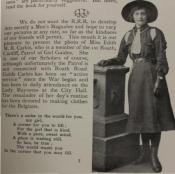Browse the collection
Sorted by unit
Edith Carbis
Place of birth: Cardiff
Service: Messenger, Girl Guides / Geidiau
Notes: Edith Carbis's photograph appeared in the 'Roath Road Roamer’, January 1915. She seems to have left school, and acted as a messenger for the Lady Mayoress.
Reference: WaW0094
Alice Lidster
Place of birth: Pontypool ?
Service: Station mistress, Great Western and Rhymney Railway
Notes: Alice, daughter of a GWR Chief Inspector, was appointed ‘station mistress’ of Troedyrhiw Halt in April 1915, probably the first such appointment in Wales. She seems to have been a trained nurse.
Sources: httpsfriendsofsaron.wordpress.comtagtroedyrhiw-halt
Reference: WaW0342

Newspaper report
Report of Alice Lidster’s appointment as ‘station mistress’. Cambria Daily Leader 20th April 1915

Newspaper report
Report of Alice Lidster’s appointment as ‘station mistress’. Pioneer 24th April 1915rnrn
Lizzie Veal
Place of birth: Cardiff
Service: Railway Worker, GWR
Notes: Lizzie Veal was associated with Roath Road Wesleyan Methodist Church, Cardiff.The Roath Road Roamer, published monthly from November 1914, contained information about women war workers as well as men. Lizzie was one of ‘our Lady Roamers’, featured in April 1919. At that time she would have been one of over 1000 women employed by the GWR as porters and ticket collectors. Image and information courtesy of Glamorgan Archives (DWESA6).
Sources: https://archifaumorgannwg.wordpress.com/
Reference: WaW0109

Lizzie Veal, Railway Worker
Lizzie Veal was a Great Western Railway worker. She may have been a porter or a ticket clerk.
Gertrude Morgan
Place of birth: Bridgend ?
Service: Ticket cillector, GWR
Notes: Gertrude, a ticket collector at Bridgend railway station, was subject to an assault by Lewis Davies, who kicked her in the thigh. He and another collier had been attempting to travel without a ticket. The magistrate said that ‘there was far too much of this hooliganism’ at Bridgend and Davies was fined £2.
Reference: WaW0458

Newspaper report
Report of the fracas at Bridgend Railway Station. Glamorgan Gazette 13th September 1918
Beatrice [B] Picton Turbervill (Picton Warlow)
Place of birth: Fownhope, Herefordshire
Service: Temperance and welfare worker, munitions hostel warden, H M Factories, before/cyn 1916 - 1918
Death: 1958, Cause not known
Memorial: Ewenny Priory, Ewenny, Vale of Glamorgan
Notes: Beatrice was the twin sister of Edith Turbervill [qv]. As a young woman she kept to her original surname of Picton-Warlow; her father changed the name when he inherited Ewenny Priory in 1891. Before the war she was a keen promoter of temperance, and was the Chair of the Cardiff branch of the British Women’s Temperance Association. In 1916 she was appointed head of one of the new munitions workers’ hostels in Woolwich. A year later she moved to Coventry as Warden of the Housing Colony for Women Munitions Workers, a large undertaking with a staff of 200, and some very unruly young workers. The ‘wild Irish-Welsh inmates … flung food and china and table furnishings at the waitresses, at each other, and through the windows’. However the Welsh Miss Picton Turbervill and her colleague the Irish Miss MacNaughton sorted the establishment out. At the end of the war she was on a lecture tour in the united states, speaking about Welfare Work in Britain. For many years after the war she was involved with Dr Barnardos.
Sources: Monthly Labor Review Volume 7 Issue 6 [US]
Reference: WaW0443

Newspaper report
Report of the AGM of the Cardiff branch of the British Women’s Temperance Association, Beatrice Picton Warlow in the chair. Evening Express 18th January 1901.

Monthly Labor Review
A report of the work of Beatrice Picton Turbervill (and her colleague Miss MacNaughton) appeared in the American journal the Monthly Labor Review.
Mabel Sybil (May) Leslie (Burr)
Place of birth: Woodlesford near Leeds
Service: Scientist, Chemist, HM Factory Penrhyndeudraeth, 1915 - 1918
Death: 1937/07/03, Bardsey, Leeds, Cancer / canser
Notes: May Leslie was born 1887, the daughter of a miner. Her father was very interested in education and self-improvement, for himself and his children. May won scholarships to High School and to Leeds University, where she gained First Class Honours in Chemistry in 1908, followed by a three year scholarship to study with Marie Curie in Paris. In 1914 she obtained an assistant lecturer’s post at University College Bangor, and in 1915 was called on to start work in the Explosive Factory in Litherland. She was promoted to Chemist in Charge of a Laboratory, a very rare position for a woman, and then moved into the same role at H M Factory Penrhyndeudraeth, working on explosives. This job ended with the War, and she returned to academic life in England.
Sources: https://newwoodlesford.xyz/schools/may-sybil-leslie/ Devotion to Their Science: Pioneer Women of Radioactivity, Rayner-Canham Marelene and Geoffrey
Reference: WaW0438
Mary Edith (Minnie) Jones
Place of birth: Llanfrothen
Service: Lady Superintendent, HM Factory Penrhyndeudraeth, 1916? - 1918
Death: 1964, Cause not known
Notes: Minnie Jones was the sister of Bessie Jones [qv]. She was appointed Lady Superintendent of the Munitions factory at Penrhyndeudraeth, probably in 1916 when it reopened after an explosion and nationalisation. In September 1918 she showed Mrs Lloyd George around the works when she came to open the new Y W C A attached to the factory. When production ceased in December 1918, Minnie was presented with a silver bowl ‘by the Women Workers of H M Factory as a mark of esteem and appreciation of many kindnesses’. Minnie was the recipient of Bessie Jones’s letters from France. She later became a JP.
Reference: WaW0441
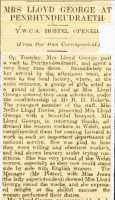
Newspaper report
Report of Mrs Lloyd George’s visit to H M Factory Penrhyndeudraeth. North Wales Chronicle13th September 1918.
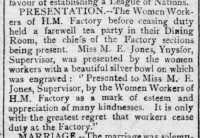
Newspaper report
Report of the presentation of a silver bowl to ‘Miss M E Jones, Supervisor’. North Wales Chronicle 13th December 1918.
Violet Williams
Service: Police constable, formerly nurse, Ministry of Munitions Women’s Police Service
Notes: Violet Williams, together with Muriel Richards [qv], was part of a ‘sting’ operation on 28th December 1918 to expose two bogus fortune tellers in Tanerdy, Abergwili. The first woman, Eleanor Rees, told Violet that a ‘dark man’ loved her, and had written her many letters that she had not received. When asked if she had written to a man, Violet replied ‘Yes – I have written to my brother several times’. She paid 6d for the session. The second woman, whom the two police constables visited later the same morning was Mary Evans. She told Violet that a ‘dark man ... in a good position under the Government’ wanted to marry her, and that they would have twelve children including two sets of twins! Mrs Evans charged her 1/- for the session. The two fortune tellers were found guilty and each fined 5/-
Reference: WaW0446
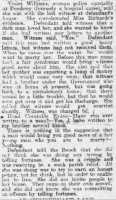
Newspaper report
Part of the court report of the trial of two fortune tellers; Violet Williams was one of two police witnesses. Carmarthen Journal 10th January 1919.
Sergeant [later Inspector] Guthrie
Service: Police Officer , Ministry of Munitions Women’s Police Service
Notes: Sergeant Guthrie began work at Pembrey in April 1917, having been a police officer for some time. According to Gabrielle West [qv] ‘Sergeant Guthrie is making this place uninhabitable, She is a most peculiar person: hair close-cropped like a man, thickset figure with no waist like a man, large feet like a man, and a sort of tenor voice like a man. The first two days, the girls wouldn’t be searched by her; they said she was a man detective, not a policewomen at all … Anyway, she is a great trial and very unbalanced.’
Sources: ed Avalon Richards Menus Munitions and Keeping the Peace: The Home Front Diaries of Gabrielle West 1914 -1917. Pen & Sword 2016.
Reference: WaW0444
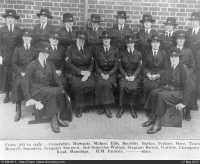
Ministry of Munitions Women’s Police Service
Women police officers at a munitions factory (not Pembrey), Sergeant Guthrie may be back row, second from right.
Muriel Richards
Service: Police constable, formerly nurse, Ministry of Munitions Women’s Police Service
Notes: Muriel Richards, together with Violet Williams [qv], was part of a ‘sting’ operation on 28th December 1918 to expose two bogus fortune tellers in Tanerdy, Abergwili. The first woman, Eleanor Rees, told Muriel that she would marry a ‘fair young man’, and that there would be opposition from her family. She paid 6d for the session. The second woman, whom the two police constables visited later the same morning was Mary Evans. She told Muriel that she would very soon meet ‘a very dark man’; they would marry and have eight children. Mrs Evans charged 1/-. The two fortune tellers were each found guilty and fined 5/-.
Reference: WaW0445
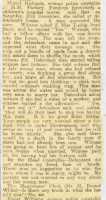
Newspaper report
Part of the court report of the trial of two fortune tellers; Muriel Richards was one of two police witnesses. Carmarthen Journal 10th January 1919.

